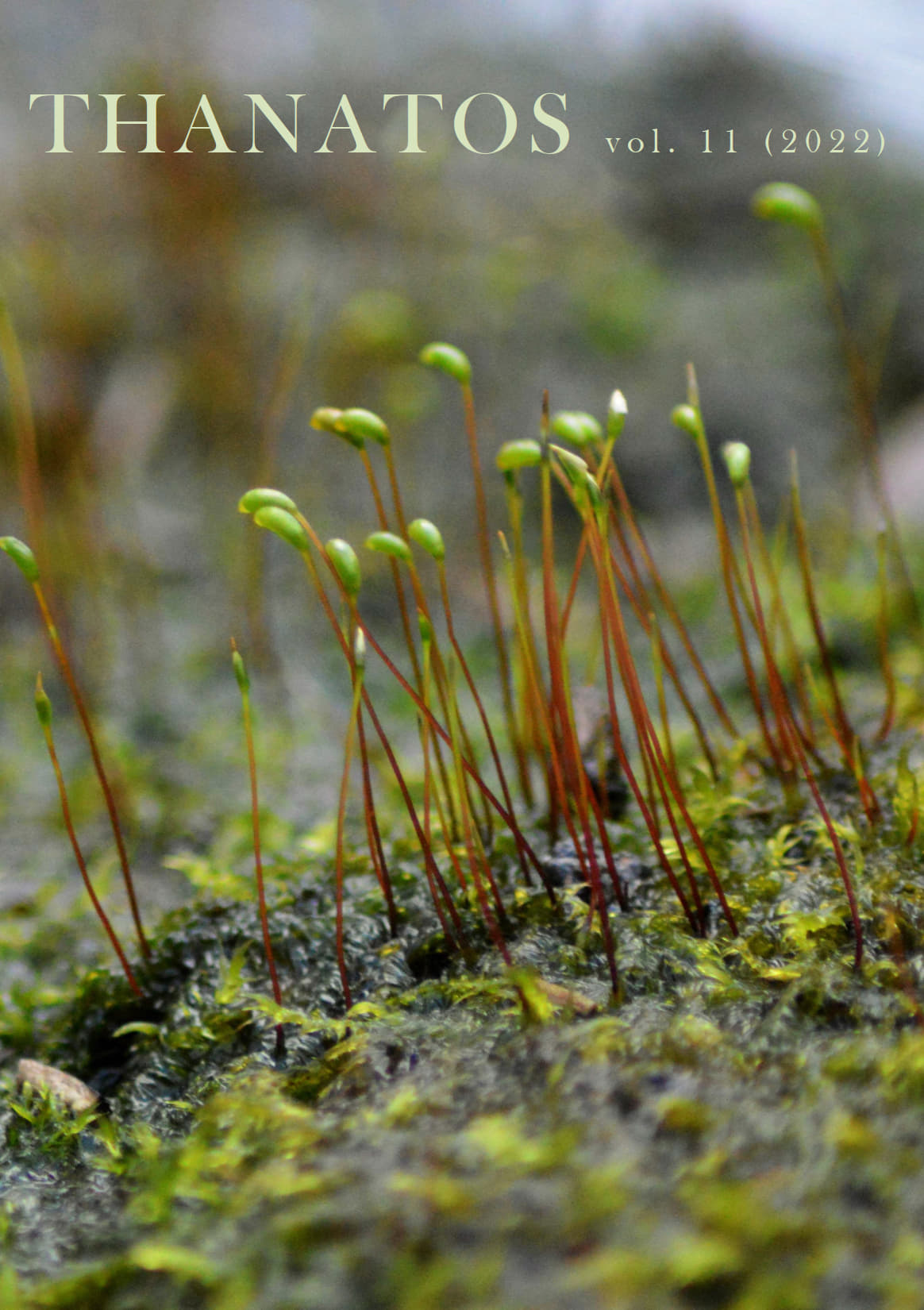Growing Grief
Cultivating Life After Death in the Garden
DOI:
https://doi.org/10.57124/thanatos.125289Avainsanat:
continuing bonds, affect theory, mourning, bereavement, gardening, memorialAbstrakti
Abstrakti englanniksi:
In this paper, I explore how cultural representations of gardens are entangled with stories of grief in productive and creative ways to demonstrate ongoing attachments and relationships with the dead. Building on the turn in grief and death studies towards a “continuing bonds” model, I argue that grief is enmeshed in the spaces and places of the past, present, and future, in relations between self and others, and in the social performance of private and public expectations. The garden is thus an ideal location in which to think about grief alongside perpetual return, persistence, and multiplicity as an activity of ongoing and future-oriented interaction with the deceased. In a range of cultural sources, including Hugo Simberg’s The Garden of Death (Kuoleman puutarha, 1896), Frances Hodgson Burnett’s The Secret Garden (1911), and Mélissa Da Costa’s Les Lendemains (2020) [The Days After], gardens and gardening feature alongside symbols and storylines of death and grief. In these works, the garden becomes a site for the construction and reconstruction of relationships between the living and the dead. Gardens, therefore, do not provide closure so much as open up avenues of communication and consolation to intertwine the living and the dead, the past, present, and future, and different places, spaces, and environments. In this paper, I show how grief, without any definitive endpoint, shapes and takes shape in the garden. In argue that there is an optimism to be found in the garden as a cultural site of grieving that does not signal detachment from the dead but employs loss as a productive and creative force for future-oriented growth and change.
Lähdeviitteet
Ahmed, Sara. 2014. The Cultural Politics of Emotion. 2nd edition. New York: Routledge.
Antonelli, Alexandre. 2020. “It’s time to re-examine the history of botanical collections.” June 25, 2020. Accessed April 5, 2022. https://www.kew.org/read-and-watch/time-to-re-examine-the-history-of-botanical-collections
Anttila, Maria. 2020. “Lempeä kuolema: Katsaus Hugo Simbergin Kuoleman puutarha -maalauksesta esitettyihin tulkintoihin.” [Sweet Death: Hugo Simberg’s The Garden of Death—An Overview of Interpretations] BA thesis, University of Jyväskylä. http://urn.fi/URN:NBN:fi:jyu-202012016843
Bonanno, George A. 2001. “Grief and Emotion: A Social-Functional Perspective.” In Handbook of Bereavement Research: Consequences, Coping, and Care, edited by Margaret Stroebe, Robert Hansson, Wolfgang Stroebe, and Henk Schut, 493–516. Washington DC: American Psychological Association. https://psycnet.apa.org/doi/10.1037/10436-021
Brown, Michael. 2018. Death in the Garden: Poisonous Plants and Their Use Throughout History. Yorkshire: Pen and Sword.
Burnett, Francis Hodgson. (1911) 2008. The Secret Garden. London: Puffin.
Burnett, Francis Hodgson. 1925. In The Garden. Boston and New York: Medici Society of America.
Casey, Edward S. 1993. Getting Back into Place: Toward a Renewed Understanding of the Place-World. Bloomington: Indiana University Press.
Charmaz, Kathy, and Melinda J. Milligan. 2006. “Grief.” In Handbook of the Sociology of Emotions, edited by Jan E. Stets and Jonathan H. Turner, 516–543. New York: Springer.
Cornish, Caroline. 2020. “Kew and Colonialism: A History of Entanglement.” March 10, 2020. Accessed April 5, 2022. https://www.kew.org/read-and-watch/kew-empire-indigo-factory-model
Da Costa, Mélissa. 2020. Les Lendemains. Paris: Albin Michel.
Derrida, Jacques. 1988. Mémoires pour Paul de Man. Paris: Galilée.
Derrida, Jacques. 1996. Apories: Mourir – s’attendre aux ‘limites de la vérité’. Paris: Galilée.
Derrida, Jacques, and Élisabeth Roudinesco. 2004. For What Tomorrow… A Dialogue. Translated by Jeff Fort. Stanford: Stanford University Press.
Erskine, John. 1917. “The Theme of Death in Paradise Lost.” PMLA 32 (4): 573–582. https://doi.org/10.1632/456939
Francis, Mark, and Randolph T. Hester. 1990. The Meaning of Gardens: Idea, Place, and Action. Cambridge, MA: MIT Press.
Freud, Sigmund. 1957. “Mourning and Melancholia.” In The Standard Edition of the Complete Psychological Works of Sigmund Freud, Volume XIV (1914–1916): On the History of the Psycho-Analytic Movement, Papers on Metapsychology and Other Works, edited and translated by James Strachey, 243–258. London: Hogarth Press.
Ginn, Franklin. 2014. “Death, Absence and Afterlife in the Garden.” Cultural Geographies 21 (2): 229–245. https://doi.org/10.1177/1474474013483220
Higgins, Kathleen Marie. 2020. “Aesthetics and the Containment of Grief.” Journal of Aesthetics and Art Criticism 78 (1): 9–20. https://doi.org/10.1111/jaac.12686
Klass, Dennis, and Edith Maria Steffen. 2017. “Introduction: Continuing Bonds—20 Years On.” In Continuing Bonds in Bereavement: New Directions for Research and Practice, edited by Dennis Klass and Edith Maria Steffen, 1–14. New York: Routledge.
Kristjánsson, Kristjan. 2018. Virtuous Emotions. Oxford: Oxford University Press.
Lin, Yeh-Jen, Chi Yun Lin, and Yu-Chan Li. 2014. “Planting Hope in Loss and Grief: Self-Care Applications of Horticultural Therapy for Grief Caregivers in Taiwan.” Death Studies 38 (9): 603–611. https://doi.org/10.1080/07481187.2013.820231
Maddrell, Avril. 2019. “Bittersweet: Mapping Grief and Consolation Through the Lens of Deceased Organ Donation.” In Consolationscapes in the Face of Loss: Grief and Consolation in Space and Time, edited by Christoph Jedan, Avril Maddrell, and Eric Venbrux, 47–60. Abingdon: Routledge.
Massumi, Brian. 1995. “The Autonomy of Affect.” Cultural Critique 31: 83–109. https://doi.org/10.2307/1354446
Massumi, Brian. 2015. Politics of Affect. Cambridge: Polity.
Neimeyer, Robert A., Dennis Klass, and Michael Robert Dennis. 2014. “A Social Constructionist Account of Grief: Loss and the Narration of Meaning.” Death Studies 38 (8): 485–498. https://doi.org/10.1080/07481187.2014.913454
Nugteren, Albertina. 2019. “Consolation and the ‘Poetics’ of the Soil in ‘Natural Burial’ Sites.” In Consolationscapes in the Face of Loss: Grief and Consolation in Space and Time, edited by Christoph Jedan, Avril Maddrell, and Eric Venbrux, 63–78. Abingdon: Routledge.
Philbrick, Antonia Leone. 1990. “Radical Growth: How the Garden Commandeers Meaning in Colette’s La Chatte.” In The Meaning of Gardens: Idea, Place, and Action, edited by Mark Francis and Randolph T. Hester, 76–79. Cambridge, MA: MIT Press.
Ratcliffe, Matthew. 2020. “Towards a Phenomenology of Grief: Insights from Merleau-Ponty.” European Journal of Philosophy 28: 657–669. https://doi.org/10.1111/ejop.12513
Sako, Katsura. 2016. “Dementia and Detection in Elizabeth is Missing and Turn of Mind.” Contemporary Women’s Writing 10: 315–333. https://doi.org/10.1093/cww/vpw011
Sarton, May. 1968. Plant Dreaming Deep. New York: W. W. Norton.
Scheffler, Samuel. 2013. “The Afterlife.” The Tanner Lectures on Human Values, Volume 32, 131–181. Salt Lake City: University of Utah Press.
Silverman, Phyllis R., and Dennis Klass. 1996. “Introduction: What’s the Problem?” In Continuing Bonds: New Understandings of Grief, edited by Dennis Klass, Phyllis R. Silverman, and Steven L. Nickman, 3–27. Washington DC: Taylor and Francis.
Wells, Bruce. 2020. “Death in the Garden of Eden.” Journal of Biblical Literature 139 (4): 639–660. https://doi.org/10.15699/jbl.1394.2020.1
Tiedostolataukset
Julkaistu
Numero
Osasto
Lisenssi
Copyright (c) 2022 Avril Tynan

Tämä työ on lisensoitu Creative Commons Nimeä-EiKaupallinen-EiMuutoksia 4.0 Kansainvälinen Julkinen -lisenssillä.





